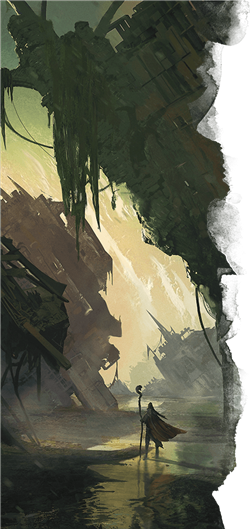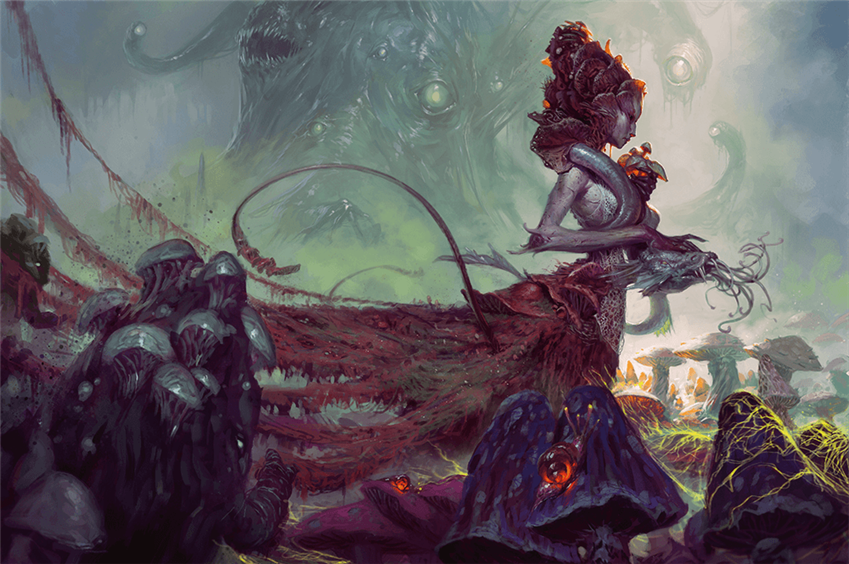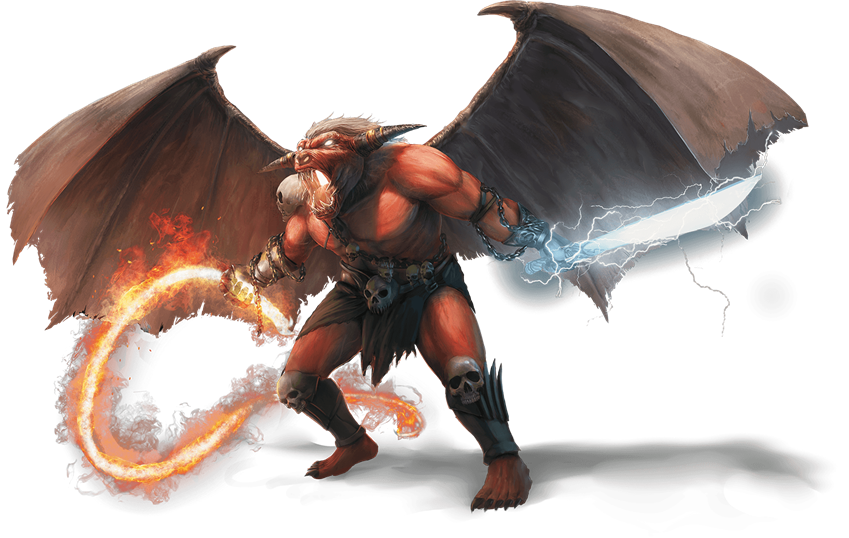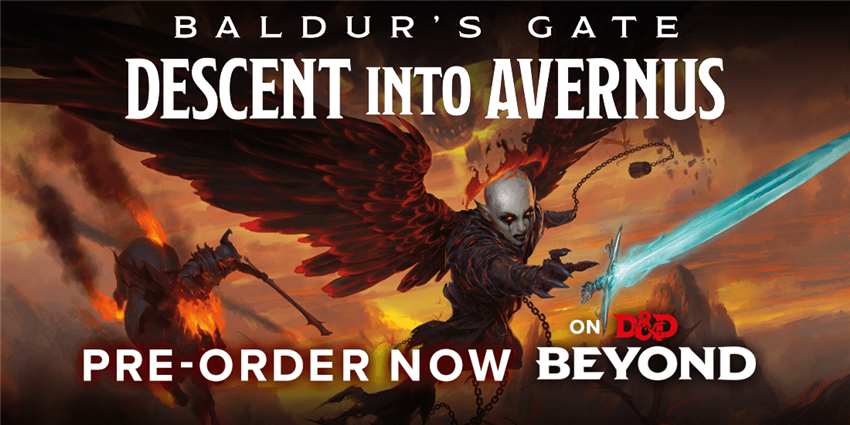“How shall any tower withstand such numbers and such reckless hate? Had I known the strength of Isengard was grown so great, maybe I should not so rashly have ridden forth to meet it.”
—Theoden, The Lord of the Rings: The Two Towers
 To make war against the endless hordes of the Infinite Layers of the Abyss is to battle against the incarnate forces of chaos and evil themselves. Just as the mortal capacity for chaos and cruelty is infinite, so too are the numbers of the demons that spawn in the Abyss’s tormented depths. Nevertheless, the devils of the Nine Hells wage the Blood War eternally, pitting demon against devil—chaos against law—evil against evil.
To make war against the endless hordes of the Infinite Layers of the Abyss is to battle against the incarnate forces of chaos and evil themselves. Just as the mortal capacity for chaos and cruelty is infinite, so too are the numbers of the demons that spawn in the Abyss’s tormented depths. Nevertheless, the devils of the Nine Hells wage the Blood War eternally, pitting demon against devil—chaos against law—evil against evil.
The existence of the Blood War is a fundamental law of the multiverse. Were the balance ever to shift, so too would the fate of the cosmos and the fates of all worlds. So sayeth Mordenkainen.
Mortals who dare supplicate themselves before demons are, without question, some of the vilest beings imaginable. Think first of humans (and elves, and dwarves, and so forth) who commit petty evils—theft, bribery, betrayal, and the like. A paladin might say that for a person to commit these temporal acts of evil, they must have been failed by society. That paladin might say they were not properly instilled with empathy for their fellow beings, they were not treated with kindness when they were starving or suffering, or something like that. And so they use the society that failed them to their selfish benefit, manipulating people’s trust in the laws that keep them safe at night for personal gain.
Devils love evildoers such as these. People who believe in laws, but only to the extent that they may profit from them. Their souls make excellent cannon fodder on the front lines of the Blood War. But there are other kinds of evil in the world than this. It is the evil that lurks in the hearts of mortals that devils fear to uncover—a deep, seething, primal hatred that kills for pleasure, indulges without need, and wishes only to see the world burn.
These mortals, who have abandoned any shred of civilization or common humanity they once possessed, become demon cultists. Wild, hedonistic, and cruel, those who worship demons are the bane of worlds, for they bring death and destruction upon not just others, but upon themselves as well. Nowhere are the terrible activities of demon cults—and the havoc spread by demons themselves—more clearer in the Forgotten Realms than in the Underdark, during the event known as the Rage of Demons, as described in the adventure Out of the Abyss. The Rage of Demons was perhaps the largest-ever incursion of extraplanar chaos into Toril, for neither demons nor devils can enter Material Plane without a being on the Material Plane summoning them or creating a portal.
All this to say, demons are horrifying, existential threat to the entire D&D multiverse. As a Dungeon Master, you should endeavor to fill your players with overwhelming dread in every encounter with demons, from the lowliest dretch to Demogorgon himself.

Chaos and Evil Incarnate
Infusing your demons with overwhelming horror starts by making these chaotic creatures feel distinct from every other wild beast or orc berserker your players have faced in your adventures so far. Countless blog posts and essays have been written on the role of alignment in D&D, but if there’s one place where alignment has a concrete use, it’s in matters of cosmic beings like demons and devils. Other creatures like a bugbear or an orc war chief might have their alignments listed as “chaotic evil,” but these alignments are descriptive; they acknowledge these creatures’ actions after the fact, and they could change if the creatures changed their behavior.
Not so for demons. A demon is representative of the chaos and evil that lurks within the hearts of mortals, and is thus intrinsically chaotic and evil. If a demon were ever to become not chaotic or evil by some miraculous force, it would no longer be a demon. What it might become is anyone’s guess, but there’s one thing it absolutely no longer be: that which it was. So, how do you (as a real-life and probably unaligned human being) portray a larger-than-life embodiment of chaos and evil? Consider these options while in combat:
Chaotic Tactics. The demon chooses its targets at random. Assign each NPC in an encounter that isn’t the demon’s ally a number (starting with 1 and ascending), and roll a die with that many sides. Whichever number comes up, that creature is the one the demon attacks.
Evil Slaughterer. In contrast to the rule above, the demon always makes sure its prey dies as painfully and as horribly as possible. The demon prioritizes creatures that are at 0 hit points over all other targets, and tries to kill them as quickly as possible.
Additionally, you should always take care to read the demon’s entry in the Monster Manual (or Volo’s Guide to Monsters, or wherever the demon appears). The story details given alongside the demon’s stat block contains vital story information that will help you roleplay the demon more easily, and it could even contain vital tactical information. Beyond the specific information presented in that description, also consider these general traits which will help you play almost any demon.
Chaotic Mind. As beings of cosmic chaos, demons are unable to focus on a single task for more than an instant. Most demons only perform tasks because they’ve been bullied into doing so by a more powerful demon. The only exceptions are when the demon is obeying the direct command of a Demon Lord, or when it is bound to a specific course of action by a geas or another form of magical compulsion, an enchantment typically placed upon it by the mortal that summoned it into the Material Plane.
Evil Spirit. A demon always tries to commit the most heinous possible acts at any given moment, as long as those urges aren’t at odds with its summoner’s or Demon Lord’s orders. Every demon’s evil urges are different as determined by its demonic type, and by the personality of the Demon Lord it serves.

Spawn of a Demon Lord
Every demon is different. Though each demon only has one illustration in the Monster Manual (or whichever book it was introduced in), that single illustration is only one of a near-infinite variations on type of demon’s physical form. As beings of chaos, it’s easy to imagine that a demon might warp or mutate over the millennia. To further diversify the infinitely mutable hordes of the Abyss, demons can also take on characteristics of the Demon Lord they serve. Demons that serve Baphomet the Horned King, for instance, are especially bestial in appearance and temperament, growing massive horns from their heads and gaining the keen directional intuition of a minotaur. Likewise, demons in the service of Yeenoghu the Beast of Butchery may become hyena-like in appearance, and gain an endless appetite for carrion.
Some of the most significant demon lords are described in chapter 1 of Mordenkainen’s Tome of Foes. That same chapter describes Demonic Boons that those Demon Lords can grant to their faithful mortal followers. You can customize your demons further by giving them those Demonic Boons to tie their appearances and abilities more closely to the Demon Lord that they serve.
Unable to retrieve the image.
Endless in Number
Just as the Infinite Depths of the Abyss extend eternally downward, so too are its hordes infinite in their vastness. The Abyss teems with the souls of the damned. For every fearsome, demi-godly balor, there are millions, perhaps billions, of pathetic manes and dretches. Fortunately, since demons must be called into the Material Plane by mortals, it’s all but impossible for the full might of the Abyss to be brought to bear at once.
There are as many demons in the Abyss as there are droplets of water in all the oceans of the world. Scholars of demonology can theoretically comprehend this fact as true, but witnessing it—actually traveling to the Abyss and seeing the writhing tide of fiendish flesh within the howling, infinite void of extraplanar nothingness—is enough to shatter even the most resilient mind. Even if one were to kill a thousand demons across the planes, it would have no effect unless that warrior were to take their battle directly to the Abyss itself, for a demon killed outside of the Abyss is reconstituted some time later within the churning depths of its home plane. Only those killed within the Abyss itself are destroyed for good.
Nowhere else in the multiverse can such a horrible sight be seen, but one place comes close. Avernus. The first of the Nine Hells and the front lines of the Blood War, Avernus is filled with roving bands of demons, emerging from the River Styx which acts as a corridor between the Abyss and the Nine Hells, clashing endlessly against devils. The River Styx is a narrow bottleneck for the Abyss’s hordes, so this most accessible of locations is nothing like the Abyss. Even if your players go to the front lines of the Blood War itself, how can you possibly impress upon them the incomprehensible horror of an enemy that is truly infinite in both number and evil?
Swarming like Rats. When the characters face a demon in combat, that demon is always joined by a group of manes. The number of manes increases proportionally to the lead demon’s challenge rating; 1d4 per level of challenge. For instance, a shadow demon would be accompanied by 4d4 manes, and a balor would be joined by a whopping 19d4 manes. These pathetic demons could be used as combatants, but you would be better off having them serve as an environmental effect. Perhaps a space occupied by four or more manes counts as difficult terrain and deals 1d4 slashing damage to any hostile creature that walks through it.
Alternatively, you could alter the swarm of poisonous snakes creature to be a swarm of manes by giving it a manes’s Damage Resistances, Damage Immunities, and Condition Immunities and removing the snakes’ poison. Each swarm of manes is composed of 8 manes. Note that turning the otherwise nebulous swarms of manes into a distinct creature makes them significantly more deadly than before. Consider this swarm’s strength when building your encounter, in this case.
A Glimpse of the Abyss. When a demon is killed outside of the Abyss, consider adding a minor cosmetic effect to its death. In the exact instant the demon is destroyed, the creature that killed it has a split-second vision of the spot in the Abyss where the demon begins to regrow. In that moment, the creature can see thousands of other demons swarming over its cocoon like so many termites.
How have you played demons in your game? Do you have any stories of truly terrifying demonic encounters?

You can pit your characters against the forces of the Abyss and the Nine Hells in Baldur’s Gate: Descent into Avernus, available in the D&D Beyond Marketplace on September 18th!
 James Haeck is the lead writer for D&D Beyond, the co-author of Waterdeep: Dragon Heist and the Critical Role Tal'Dorei Campaign Setting, a member of the Guild Adepts, and a freelance writer for Wizards of the Coast, the D&D Adventurers League, and other RPG companies. He lives in Seattle, Washington with his partner Hannah and their animal companions Mei and Marzipan. You can find him wasting time on Twitter at @jamesjhaeck.
James Haeck is the lead writer for D&D Beyond, the co-author of Waterdeep: Dragon Heist and the Critical Role Tal'Dorei Campaign Setting, a member of the Guild Adepts, and a freelance writer for Wizards of the Coast, the D&D Adventurers League, and other RPG companies. He lives in Seattle, Washington with his partner Hannah and their animal companions Mei and Marzipan. You can find him wasting time on Twitter at @jamesjhaeck.








-
View User Profile
-
Send Message
Posted Sep 20, 2019Amazing article as always! The Swarming like Rats part reminded me of when the players opened a box labeled “Rats”, and out came a swarm of rats (one of the players also set the floor on fire at that moment). Keep up the great work!
-
View User Profile
-
Send Message
Posted Sep 20, 2019Great Article! This pairs nicely with the Devil's article, and Descent into Avernus should be even better with these
-
View User Profile
-
Send Message
Posted Sep 20, 2019Great article as always!
Just one minor typo, though: "Other creatures like a bugbear or an [Tooltip Not Found]..."
-
View User Profile
-
Send Message
Posted Sep 20, 2019Ah, our old friend, [Tooltip Not Found], a creature so Chaotic it cannot even be linked to.
-
View User Profile
-
Send Message
Posted Sep 21, 2019Someone needs to make a subclass of the warlock, a pact with the [Tooltip Not Found].
-
View User Profile
-
Send Message
Posted Sep 21, 2019It’s mentally catastrophic power would be ENDLESS!!
-
View User Profile
-
Send Message
Posted Sep 21, 2019Also, I’d like to add that, in my experience, demons LOVE torture. The only reason for a demon to capture and not kill is if he wants to torture, and a demon will usually only capture if he has a reason to torture that specific person. So, he would capture one of the character’s friends and torture him in order to lure the characters to him and into danger. It makes a great hook to pull players in a specific direction.
-
View User Profile
-
Send Message
Posted Sep 21, 2019SCP - ●●|●●●●●|●●|● has breached containment
-
View User Profile
-
Send Message
Posted Sep 21, 2019What does tooltip even mean?
-
View User Profile
-
Send Message
Posted Sep 21, 2019Shout-out to Demogorgon
-
View User Profile
-
Send Message
Posted Sep 21, 2019Oh god. What's funny is that this article has been ready for a few days and nobody thought to proofread it.
-
View User Profile
-
Send Message
Posted Sep 21, 2019Lovely article. Very informative.
I rather wish some of the named lesser known Demon Lords would get more fleshing out.
Highest on that list for me would be the Demon Lord Chernovog, the Green God (Evil Druids, Vengeful Nature, Warlocks, evil fey) and his realm, the Verdant Chasm.
I'd always love to see what official information on him would be like, but in my game lore, he was an ancient Cernunnos/Pan sort of Archfey that became corrupted by the Abyss and became a Demon Lord.
-
View User Profile
-
Send Message
Posted Sep 21, 2019I understood that reference!
-
View User Profile
-
Send Message
Posted Sep 21, 2019our swarm rules when large groups of low level critters get together | eliminate the attack roll, and instead have victim characters make a saving throw to half the damage. For example, a creature who deals 1d8 damage normally is grouped into a swarm (for which we use a single token), and that swarm deals 5d8 damage instead, with a Dexterity or Strength DC equal to [10] +hit to save to half.
The swarm gets HP for each creature in the swarm, retains its AC and defensive properties, but takes double damage from a spell or attack that travels in a beam, and triple damage from a splash (aoe) spell like a fireball.
-
View User Profile
-
Send Message
Posted Sep 21, 2019Great Article.
If you decide to us lots of manes you could add the cleaving rule from DMG.
-
View User Profile
-
Send Message
Posted Sep 21, 2019Content like this should be indexed to the actual books as an online supplement with whatever disclaimer one needs. It's useful, but after a few weeks after launch, it becomes obscure. Whereas these are some genuinely good pointers that should, in some form, be preserved for D&D Beyond users who are not running these adventures "at launch". The ones for Dragon Heist were also particularly good.
Either index them to the digital copies of the books, or have an additional tab for supplementary articles to the various books, so we can handily find them by adventure.
-
View User Profile
-
Send Message
Posted Sep 21, 2019Transmission ●●|●●●●●|6: Following [REDACTED], SCP-649 has also breached containment, and is moving rapidly through the facility towards [REDACTED] We can't stop its progress, and it seems intent on reaching [REDACTED] Send the remaining security squads, and prepare the acid drop if necessary. Wait! What's that? Something's coming out of... HEY! RUN! RUN! [gunfire] [screaming]
End transmission
-
View User Profile
-
Send Message
Posted Sep 21, 2019No, I seriously want to know.
-
View User Profile
-
Send Message
Posted Sep 21, 2019A tooltip is that window that pops up when you mouseover specially linked text, like this: orc. Thanks for asking!
-
View User Profile
-
Send Message
Posted Sep 21, 2019Thanks for answering!